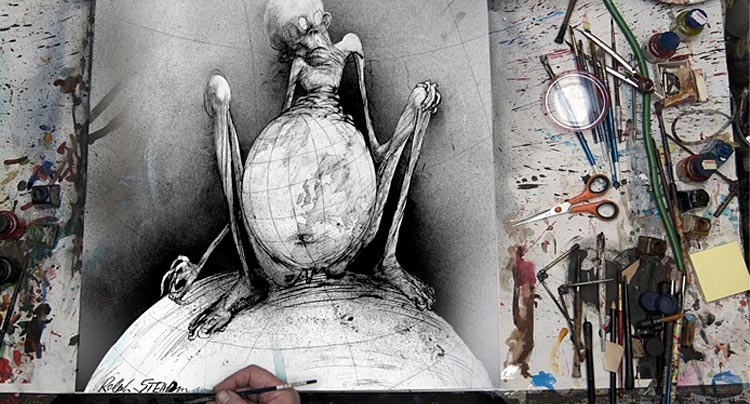
An entertaining, albeit shallow, documentary on the life and work of Gonzo artist Ralph Steadman.

An entertaining, albeit shallow, documentary on the life and work of Gonzo artist Ralph Steadman.
For No Good Reason (2012), released by Sony Pictures Classics, is a unique documentary on the life and work of Gonzo artist Ralph Steadman. Framed as an extended interview conducted by Johnny Depp, the film features an impressive roster of appearances beyond its two headliners, including Terry Gilliam, Hal Willner, and Richard E. Grant (not to mention some interesting footage of Hunter S. Thompson and William S. Burroughs). The film moves back and forth between Steadman’s personal history, the writers and artists who influenced and collaborated with him, along with his style and technique. As a person with only a passing knowledge of Gonzo journalism, I found the film more interesting for it’s portrayal of life from the sixties into the eighties, discussing the political and social revolutions (and subsequent disillusion) of an entire generation. From Civil Rights and women’s empowerment into the decadence of the following decades, Steadman’s work documents an important time in American and western history. The film does a decent job linking Steadman with the other great writers and artists of the era– as Terry Gilliam said during an interview concerning their generation, they are part of a generation that fought hard for change, and despite their failures plan on fighting till the very end. The film was certainly educational, and for those interested in the radical experiments of the sixties and seventies, may very well be inspirational as well. Indeed, thinking of Steadman’s embrace of the grotesque in his art, highlighting the humor, irony, and horror of daily life, makes for a very powerful lesson. Yet despite it’s self-conscious striving for some deeper understanding of art, beauty, society, etc., in many ways we learn little about Ralph Steadman. The film offers only a passing view of Steadman as a person, something more akin to a guided Disney tour than a thorough investigation of his life. Johnny Depp’s deep involvement with the project, from it’s dramatic stylization, to the grating “Tim-Burtonesque” soundtrack, is undeniable, and ultimately for the worse. The obvious hero worship and romanticization of Steadman and Hunter S. Thompson’s drinking/drug life, paired with the film’s ridiculously high production value, all makes for a stylized and manicured take on the lives of these artists.

While the film nails home the importance of Steadman’s work (which indeed it should), the contradictions, hypocrisies and inconsistencies of his life ultimately remain hidden from us. For No Good Reason also features an insistent undercurrent that asserts Steadman’s equality with (if not preeminence over) Hunter S. Thompson in crafting Gonzo journalism. In between the copious discussions of their rowdy collaborations, the film slips in a claim that Steadman was the “braver” and more forward thinking artist in the creative duo. Yet in its insistence, the documentary becomes too eager to make its point, nearly manic to assert Steadman’s value as a creator. There is a brief moment in the film where we watch a recorded conversation between Steadman and Thompson, where the artist states that his illustrations were at least partially responsible for the success of Fear and Loathing in Las Vegas. Expecting Thompson to acknowledge his contribution, Steadman only received derisive laughter in reply– apparently, little recognition was offered.
This aspect of Mr. Steadman’s life and work, those deep-seated insecurities the film unwittingly brings to the surface, are neither broached nor alluded to. What Mr. Steadman thinks or feels about Thompson’s work, or the fact that his long-time collaborator is better known and receives greater acknowledgement, is never addressed. The questions are all soft-balled, the answers charming, and we all go home happy– this wouldn’t be a problem though, except for the documentary having explicitly stated it would try to create a multisided view of Mr. Steadman’s life.
The less savory side of Mr. Steadman (from his apparent capitalist drive in selling signed prints of his work, to his jealousy over his former partner,) was largely varnished over. What darkness remains is either written off as “acting out of necessity” or portrayed in some manner of victimization. Ultimately, For No Good Reason appears as another example of what’s become Mr. Depp’s “signature” style– dark, affected, and elaborately quirky. Yet putting these mannerisms aside, the film does afford viewers an interesting perspective on an important era in our history, the decent look at the life and work of an important artist, and a really great home-movie of William S. Burroughs, emptying a .38 caliber handgun into Shakespeare’s neck. For those interested in Gonzo, the Beatniks, or the freewheeling, august beauty of Latter-Day Hippiedom, this film is worth it.